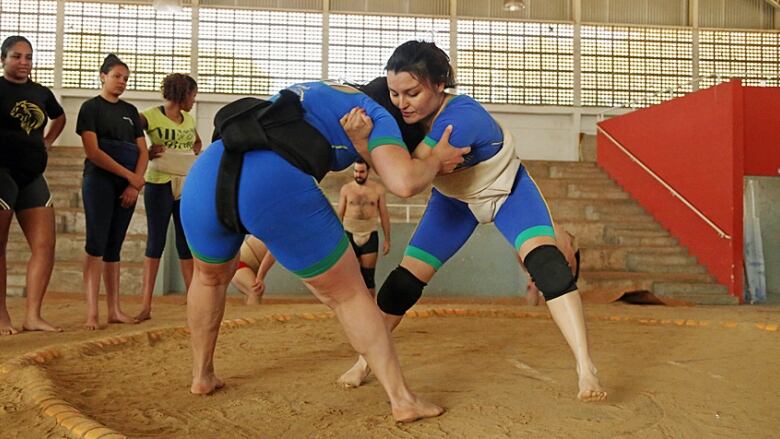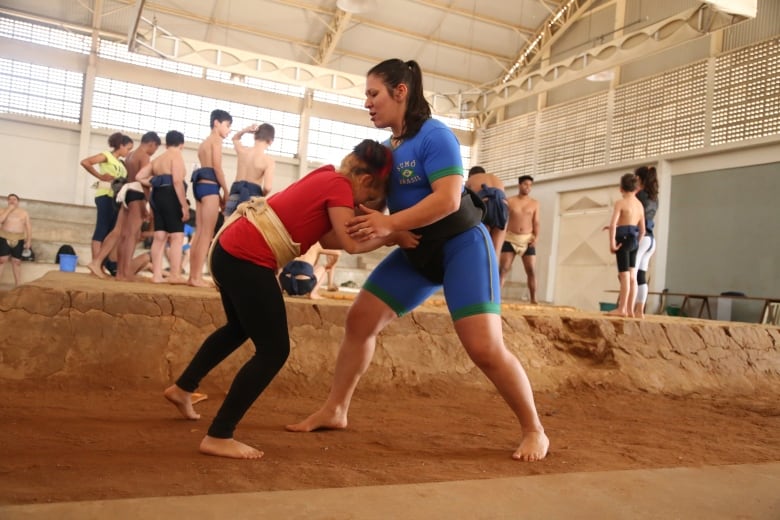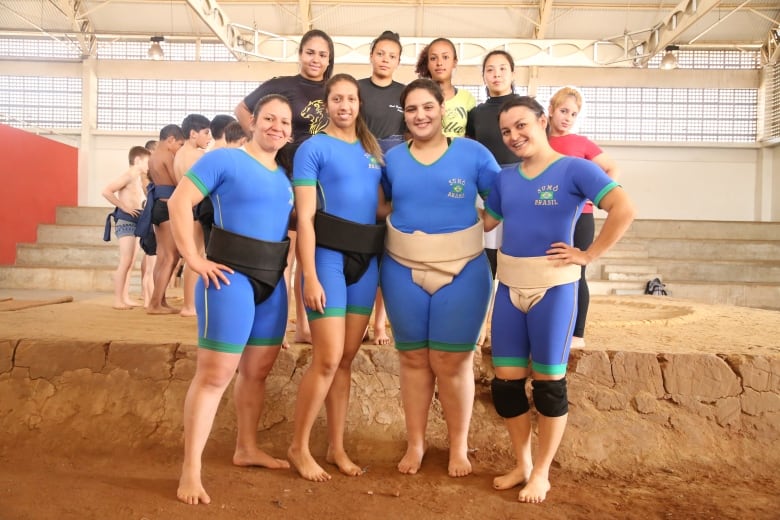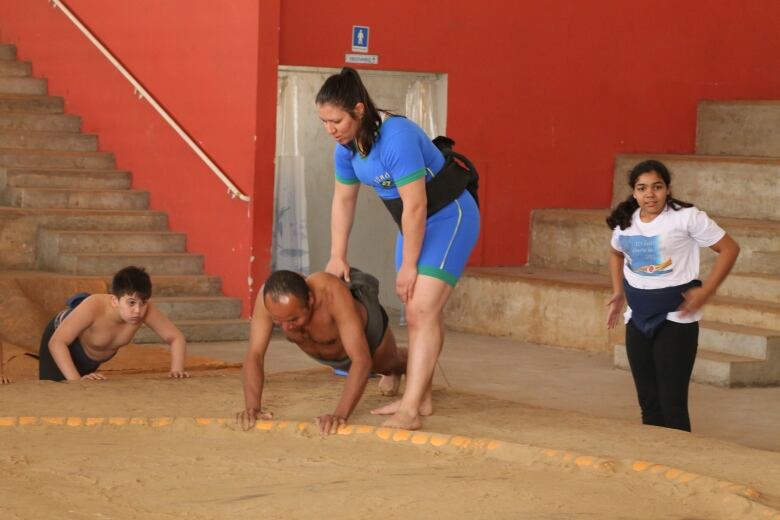'Sumo feminino': How Brazil's female sumo wrestlers are knocking down gender barriers
Long banned from sumo as 'impure,' women roar back with Olympic-sized ambitions

The combatants enter the clay ring barefoot. Luciana Watanabe cracks her neck. Her opponent, Fernanda Pelegrini, smoothes her ponytail. The Brazilian sumo wrestlers lower their fists to the dirt, their bodies loaded in a linebacker's squat.
They grapple, unleashing a fit of tugs and twists. Pelegrini plows into Watanabe, whose feet skid across the sand. The pair spins wildly. Watanabe seizes Pelegrini by the mawashi, the Japanese loincloth worn during matches, almost heaving her outside the circle. But Pelegrini locks in. She hoists Watanabe out, winning the bout.
At Sao Paulo's Estadio Municipal Mie Nishi de Sumo the only sumo-exclusive training facility in the world outside Japan women aren't just cracking a glass ceiling in a centuries-old sport; they're stomping on the floors.
"It takes strength. Technique. Explosiveness," says Watanabe, a 31-year-old who isamong the best-known worldwide in her lightweight (under 65 kilograms) division. "Female sumo is a paradigm shift. It's challenging prejudices."
Watanabe is a pioneer in the increasingly popular martial art of "sumo feminino" in Brazil and Eastern Europe, and a loud voice in the push by theInternational Sumo Federation to introduce the sport as an Olympic medalling event for men and women.
She's also a coach, barking instructions to teen boys and girls during free lessons on Sundays.

"Hakkeyoi!" she commands, chopping her hand through the air to signal the beginning of a new matchas a boy and a girl barrel towards each other.
Mixed-gender sparring is common here. During one bout, a teen girl in a neon-yellow shirt ambles toward her smaller opponent, a bare-chested boy no older than five. She hoists him by his mawashi, easily depositing him outside the 4.55-metre-diameter wrestling boundary known as a dohyo.
It's over after barely five seconds. The wrestlers bow to each other.
'Equal-opportunity sport'
"We see sumo as an equal-opportunity sport," says Watanabe, whose grandfather was Japaneseand who counts herself among Brazil's nearly two million Nikkei descendants, the largest Japanese population outside the birthplace of sumo.
The phys ed teacher, who packs a stocky rugby player's physique, has tried for more than a decade to prove females deserve a place in the dohyo an exclusively male domain by a 1,500-year-old tradition.
"There was this myth that women bring bad luck," says Willian Higuchi, vice-president of the Brazilian Association of Sumo, explaining that sumo's originators believed women were "impure" and might sully the ring.
"In the past, women could not even touch a professional sumo wrestler. When I was a little kid, my mom could not wash my mawashi."
Another view during warm-ups of the "dohyo," the sumo-wrestling ring, at So Paulo's sumo training gym pic.twitter.com/36iFPoJ7lA
—@matt_kwongIn 2000, Japan's first female governor, Fusae Ota, was prohibited from entering a dohyo to award prizes at a professional sumo tournament. Her male deputy performed the duties in her place.A year later, the International Sumo Federation opened the firstWomen Sumo World Championshipsin Japan.
More cracks are forming in the once-unbreachable clay surface banning female sumo competitors. Watanabe has an international platform to make her case.
Last Tuesday, the 14-time Brazilian sumo champion hoisted the Rio 2016 Olympic torch as part of the official torch relay, carrying the flame through her hometown of Suzano. It was a recognition of female sumo's prominence in this South American country as it readies to host the 2016 Summer Games.
"You don't have to be a man to do it. You don't have to be fat to do it. You don't have to be Japanese," says Watanabe, who hopes to see sumo in the Olympics, maybe by 2024 three decades after Olympic authorities mandated against single-sex events.
"Hakkeyoi!" Brazil national female sumo teammates Fernanda Peligrini, left, & Lu Watanabe (an Olympic torchbearer!) pic.twitter.com/Mk16pp9XWH
—@matt_kwongRunning drills
She estimates there are as many as 600 sumo practitioners of both genders across Brazil, with most training across Sao Paulo's seven wrestling associations.
"I feel proud to be a female wrestler because I was one of the first ones," she says, flashing a mouthful of braces. "I saw the history of female sumo, and now there are little kids wrestling, and they say they get inspired by me, so I get even happier."
Pelegrini, a middleweight (6580 kg) competitor who also wrestles on the Brazilian women's national team with Watanabe, brings her niece, Dandara, to the Sunday classes. They run grappling drills together.
Brazil loves its sumo. Inside a free sumo wrestling class in So Paulo with coach Willian Higuchi pic.twitter.com/gPxbBrwH7s
—@matt_kwong"I think it's super cool to wrestle sumo," the 10-year-old says, adding she wants to be a sumo wrestler like her aunt some day.
Strong women can inhabit different physical forms, but technique is more prized than size, Watanabe says. And although body image issues exist in Brazil as they do in Canada and the U.S., beach culture also includes all manner of shapes and sizes. Not only the slender flaunt microscopic bikinis.

Higuchi pitches sumo as an activity that welcomes would-be athletes struggling to find a sport that suits their body type.
"There's a stigma that sumo wrestlers have to be fat. That's not true at all," Higuchi says. "But there are many kids who couldn't do any sports because they were overweight, and they come to sumo and they found themselves."
Not too expensive
Also key to bringing sumo to the masses is accessibility across ethnicities and social classes.
"Sumo is a cheap sport to practise," Higuchi says.
That's an important point in a countrystruggling through an economic crisisand where monthly wages average roughly 2,000 Brazilian reais ($800 Cdn). Many of the families learning the sport come from lower income brackets. The only equipment needed is a mawashi, which would cost less than $40.
Still, that can be prohibitively expensive for some families. When youth competitor Sarah Gomes began training, she borrowed a mawashi from her mentor, Watanabe.
#Rio2016 Olympic torchbearer Lu Watanabe shows off the collapsible torch and its motif of Rio waves and mountains pic.twitter.com/J376N8cIu7
—@matt_kwongLast year, when the 16-year-old was selected to compete in the junior women's category in the Sumo World Championships in Osaka, Japan, her mother, Elaine Silva, posted on Facebook asking for help to cover travel costs. Friends donated rice pans and toasters to sell.
Gomes, with a streak of blue in her ponytail, came to sumo after her judo sensei suggested she try switching about two years ago. Her mother was insulted at first, believing the remark was because her daughter is "gordinha," Portuguese for chubby.
"Then we saw Luciana. We saw she's small and thin. We realized it's nothing to do with that," Silva says.

The teen wrestler's family now feels Gomes is breaking a gender barrier.
"She loves it so much that there's no difference between the girls and the boys wrestling," Silva says. "Boys, girls, they all wrestle together. She's very strong. And the boys also know that."












_(720p).jpg)


 OFFICIAL HD MUSIC VIDEO.jpg)
.jpg)



























































































